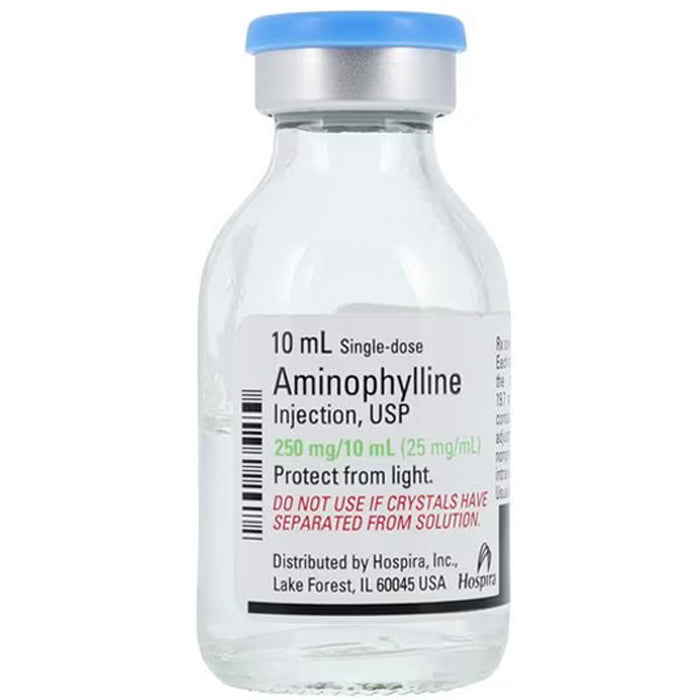Aminophylline for Injection 250 mg Single-dose Vial 10 mL x 25/Tray (Rx)
(Note: We don’t Fill Personal Prescriptions)
How to Order:
You will receive instructions on how to create an account along with Rx Ordering Details.
Aminophylline for Injection 250 mg is a bronchodilator used to treat and manage symptoms of asthma, chronic obstructive pulmonary disease (COPD), and other lung diseases associated with bronchospasm. It works by relaxing the muscles around the airways, improving breathing and airflow in patients experiencing difficulty in breathing. Aminophylline is typically administered intravenously in hospital settings for acute asthma attacks or severe COPD exacerbations, ensuring rapid action to relieve respiratory distress.
Aminophylline for Injection by Pfizer Injectables is a bronchodilator used primarily to treat and prevent symptoms of asthma, chronic bronchitis, emphysema, and other lung diseases. It is available in the form of a 250 mg single-dose vial, with a volume of 10 mL per vial. Packaged in a tray of 25 vials, this formulation is intended for intravenous administration to provide rapid relief in acute respiratory emergencies.
Details and Features
Active Ingredient: Aminophylline (a complex of theophylline and ethylenediamine)
Concentration: 25 mg/mL
Volume: 10 mL per vial
Packaging: Tray containing 25 single-dose vials
Route of Administration: Intravenous (IV)
Indications: Primarily used for the treatment of acute asthma attacks, chronic obstructive pulmonary disease (COPD), and other situations requiring bronchodilation.
Mechanism of Action
Aminophylline works by relaxing the smooth muscles of the bronchial airways and pulmonary blood vessels. It does this by inhibiting phosphodiesterase enzymes, leading to an increase in cyclic AMP levels in the cells. The elevated cAMP helps in relaxing the tracheal and bronchial muscles while decreasing airway reactivity and inflammation. Additionally, aminophylline has mild diuretic effects and central nervous system stimulation.
Warnings
-
Therapeutic Monitoring: Regular monitoring of serum theophylline levels is essential to avoid toxicity, as the therapeutic range is narrow.
-
Cardiovascular Effects: Can cause arrhythmias and palpitations, particularly in patients with pre-existing heart conditions.
-
Seizure Risk: May lower the seizure threshold, especially at supra-therapeutic levels.
-
Drug Interactions: Aminophylline can interact with various drugs, including cimetidine, fluoroquinolones, and certain anticonvulsants, affecting its metabolism.
- Conditions: Caution is advised in patients with hepatic impairment, heart failure, or hypothyroidism, as these conditions might alter the drug's pharmacokinetics.
Side Effects
While effective, aminophylline may cause side effects, particularly if serum levels are not properly monitored or if the patient has contraindicating factors:
Common Side Effects:
- Nausea
- Vomiting
- Headache
- Insomnia
- Nervousness or tremors
Serious Side Effects:
- Cardiac arrhythmias
- Seizures
- Severe hypotension
- Gastrointestinal hemorrhage
Patients receiving aminophylline must be closely monitored by healthcare professionals to ensure therapeutic levels are maintained and side effects are minimized. Regular assessment of drug levels, especially during dose adjustments, is critical to avoid toxic effects. Patient-specific factors such as age, weight, and comorbid conditions should guide dosing and monitoring strategies.

